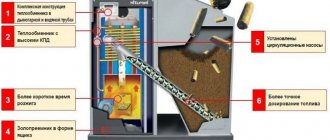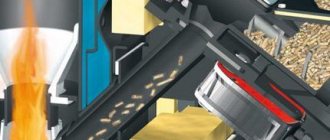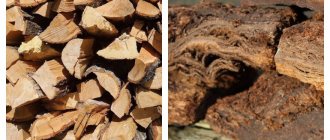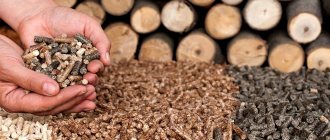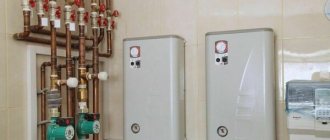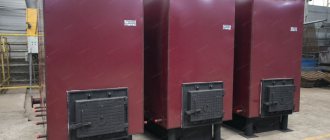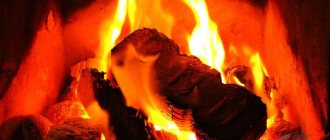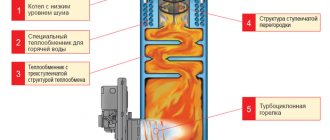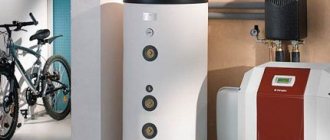Home / Solid fuel boilers
Back
Published: 05/24/2019
Reading time: 7 min
0
2890
In the absence of the opportunity to connect to a centralized gas supply system, the owners of private houses and country houses decide to install an automatic solid fuel boiler.
The fuel used in such units is firewood, coal, peat or sawdust (pellets). But since manual loading of the listed raw materials becomes difficult, many consumers prefer devices with automation of this process.
- 1 Operating principle of automatic long-burning boilers
- 2 Difference from semi-automatic boilers
- 3 Internal structure
- 4 Types of automatic boilers
- 5 Requirements for installation of an automatic solid fuel boiler
- 6 5 best boilers with automatic fuel supply
Operating principle of pellet boilers
Essentially, this is a solid fuel unit that uses pellets as fuel. These are granules that are made from wood waste (bark, sawdust, shavings), peat or straw. They have a cylindrical configuration. High-quality environmentally friendly fuel does not pollute the atmosphere and is harmless to humans.
Pellet boilers differ from conventional solid fuel units in that the fuel supply process can be fully automated. Thanks to this, the device can operate with minimal human intervention.
Pellet heating boilers consist of a bunker for storing and supplying fuel, a burner and an automation system. Augers are installed to feed pellets into the pre-furnace room. From there, the granules are transported via an external screw to the burner nozzle. Here they automatically ignite and burn completely.
Important! The heat transfer of one kilogram of pellets is equivalent to the combustion of 0.5 liters of diesel fuel. This unit is equal to 5 kW/h.
Compared to firewood, pellets burn more efficiently and provide more thermal energy. At the same time, pellets cannot spontaneously ignite. Ashes can only be removed once a week. The amount of carbon dioxide that the boiler emits into the atmosphere is much lower, which is important for protection against the greenhouse effect.
Difference from semi-automatic boilers
Photo source: kijiji.ca
Unlike semi-automatic models, where only the rotation speed of the fan blades is controlled, automatic units are also able to control the intensity of fuel loading. The feedstock is supplied using a screw mechanism from a special warehouse. In appearance, the installation is similar to a meat grinder, but the role of meat is played by the fuel composition. It is used as:
- Coal (hard or brown).
- Pellets.
Automatic long-burning coal boilers can operate for 3-4 days without reloading fuel. And if the owners are forced to leave the premises, it is enough to activate the defrost protection mode, in which the system will maintain the optimal temperature. A semi-automatic boiler requires direct human intervention.
Pros and cons of pellet boilers
Today, a pellet heating boiler is the main competitor of gas heating equipment.
The advantages of pellet boilers include the following:
The operating principle of condensing gas heating boilers and how to choose
- The efficiency of the heating unit reaches 97%.
- Completely safe device. It does not emit harmful emissions and does not harm human health.
- The burning duration of a pellet unit after one load of fuel is much longer than all other types of solid fuel boilers.
- Thanks to automation, constant human participation in the operation of the boiler is not required. The device does not require special maintenance.
- To determine the air temperature, you can install remote sensors.
- You can control the operation of the boiler remotely. To do this, just install a mobile application or a GSM module.
Among the disadvantages of this heating equipment are the following:
- the price of one unit of generated heat is quite high;
- This device is a volatile device, so in remote settlements for uninterrupted operation of the boiler you will have to buy a generator and additional technical equipment.
Important! In a month, about a ton of pellet fuel burns in the boiler, so the heating device cannot be called economical.
Types of pellet boilers
Depending on the fuel used, such boilers can be exclusively pellet or combined. The first type works on granular raw materials. Combined-type devices can operate on pellets and other types of fuel, for example, sawdust heating can be used.
Also, devices may differ in the design of the gas burner. According to this parameter, they are divided into units with a retort and a torch burner. Moreover, the first type of burners is used only in pellet boilers, and flare burners are used in combined heating appliances.
Based on the principle of fuel supply to the bunker, the units are divided into the following types:
- mechanical;
- automatic;
- semi-automatic.
To regulate automatic fuel supply, the boiler must be programmed by specialists. Semi-automatic boilers can be adjusted manually. Mechanical units use manual feeding of pellets into the hopper. There are also pellet boilers with a water circuit. The choice of a specific variety depends on the type of heating system at home and the climatic characteristics of the region.
Design and principle of operation
Regardless of the manufacturer, the fan consists of an aluminum or galvanized housing, inside of which there is an electric motor, guide blades and protection in the form of a lattice fence.
This design, despite its simplicity and small dimensions, is reliable. A damper is installed on the supercharger, which is designed to limit the penetration of flue gases into the combustion room in the event of reverse draft.
Also, the damper reduces natural draft when there is no air supply.
The connecting pipes can be located in the upper part of the housing or on the front part of the blowing unit and have various forms of connectors for connection to the boiler. Algorithm for the functioning of the boiler control system using blown air:
- the heating device is filled with solid fuel and ignited;
- the blower is turned on and the air flow is regulated;
- when air is supplied to the combustion zone, intense combustion of the fuel begins, and therefore the temperature of the coolant begins to rise;
- when the temperature reaches the set value, the control unit controller gives a signal to turn off the supercharger;
- air deficiency will lead to a decrease in the intensity of fuel combustion and a decrease in coolant temperature.
How to choose a pellet heating boiler?
When choosing a pellet boiler, pay attention to the following characteristics:
- Pure pellet boilers can only use this type of fuel. In conventionally combined units, granules and coal are also used. Combination boilers operate on different types of fuel. They are quite bulky because they have two fuel chambers.
- Be sure to consider the type of fuel supply. Manual feeding is quite energy-intensive and inconvenient, so it is only suitable for a country house. With semi-automatic feeding, you only need to adjust the amount of granules. Automatic feeding is the most convenient, but you will have to invite specialists to set it up.
- Flare burners are popular because they rarely clog. The direction of the flame in them is horizontal. In retort burners the flame is directed vertically. Their work is safe and silent.
- The choice of boiler power depends on the size of the house. To heat 10 square meters of space in a room up to three meters high, a boiler power of 1 kW is needed. To heat a house with an area of 100 m², you need to burn 1100 grams of pellets within an hour.
- There are devices with steel and cast iron heat exchanger. Units with a steel heat exchanger are more common. Cast iron structures are heavy and more difficult to clean, but they are resistant to corrosion.
The frequency of boiler maintenance depends on the capacity of the fuel bunker. Standard models can be loaded with fuel for 4-5 days. You can install a separate bin with a month's supply of pellets. The ash pan is cleaned once every two weeks, and the fuel chamber needs to be cleaned every 7-21 days (depending on the manufacturer’s recommendations).
Boiler room installation and remote control of a gas boiler
What to look for when choosing
In the table below we have given the main operational characteristics of automatic coal boilers, which are considered the norm.
| Parameter | Classical | Pyrolysis |
| Efficiency | 78%-84% | 85%- 95% |
| Refueling the bunker | Up to 5 days | 4-7 days |
| Fuel moisture | 20%-30% | 7%-15% |
| Coal fraction | 25 mm - 50 mm | 5 mm – 25 mm |
| Ash content | Up to 25% | Up to 15% |
Efficiency factor (efficiency) is the ratio of the amount of fuel consumed to the amount of thermal power produced by the boiler; the higher it is, the better. The boiler power is determined by calculations for heating a specific room and the necessary consumption of hot water; we will consider the calculation principle itself later.
After choosing the main characteristics, you need to pay attention to the additional properties of the future unit, the presence of which increases comfort and price:
- degree of equipment automation (additional options from ash unloading to control from a mobile phone);
- heat exchanger material (cast iron is more durable, steel is cheaper, lighter and more repairable);
- combustion chamber volume. The more, the less often the fuel supply is turned on, making noise and consuming electricity;
- chimney size and design;
- fire safety.
The modern market is ready to fully provide the desired set of boiler properties; the only question is the budget.
Boilers with a burning duration of one load of fuel up to 7 days
Production of pellets for heating boilers
Do not confuse pellets and briquettes for the boiler. The former are small cylindrical granules, while the latter are larger in size and are produced in the form of bricks.
Industrial pellets are made from the following types of raw materials:
- straw from grain processing;
- wood waste (chips, sawdust);
- buckwheat and sunflower husks.
The sequence of making pellets is as follows:
- First, the raw materials are crushed and ground in industrial crushers.
- The mixture is dried to a moisture content of no more than 10%. All dryers operate on the principle of releasing thermal energy.
- To make the granules better shaped, they are treated with steam. Moreover, the humidity of the raw materials increases slightly.
- After this, the prepared raw materials are pressed into granules using a special press. The pellets are molded under a pressure of 300 bar. Typically a cylindrical die press is used.
- The finished product is allowed to cool and packaged.
Rules for storing pellets
Granulated fuel can be stored in special bunkers, outdoors or indoors, but it must not be allowed to get wet. Storage temperature does not matter, because pellets tolerate heat and frost equally well.
When storing fuel, adhere to the following rules:
- pellets are stored on racks made of metal, plastic or wood;
- bags of fuel should not come into contact with the floor or ground;
- in frosty weather outside, the bags can be laid directly on the snow, and in the summer they are protected from sunlight;
- storage areas are protected from rain by canopies made of polyethylene film, slate or tarpaulin;
- Granules can be stored year-round in sealed bins.
The best domestic pellet boilers
The most popular models of pellet boilers are:
- Kiturami units are manufactured in South Korea. The positive qualities of this equipment include high efficiency, reaching up to 94%, a modified hopper and electronic burner adjustment. The heater has protection against overheating and is fire resistant. The set includes a remote control. The double-circuit boiler comes with a 2-year warranty. Specifications:
- weight – 310 kg;
- power – 24 kW;
- Hopper volume – 160 kg;
- fuel consumption – 5.5 kg per hour;
- maximum heated area – 300 m²;
- price – $3230 (210 thousand rubles).
- Czech pellet heaters OPOP BIOPEL are made of heat-resistant steel. The device is suitable for domestic use or heating industrial premises. Vertical heat exchangers increase efficiency up to 92%. It is possible to remotely control the operation of the equipment. The device has an ash removal and self-cleaning system for the burner and heat exchanger. The heater power is in the range of 10-200 kW.
- Domestic Zota boilers are produced with different capacities. The most popular unit has automatic ignition of pellets. The device comes with temperature sensors for installation indoors and outdoors. It is possible to remotely adjust the operation of the equipment. The Zota Pellet 15A model is a combined unit that can operate on other types of fuel. Specifications:
- weight – 318 kg;
- power – 15 kW;
- fuel tank capacity - 293 liters;
- fuel consumption – 3-4 kg per hour;
- heated area – 150 square meters.
- The Russian plant Teplodar produces different types of boilers. The most reasonable price is for Kupper pellet units. Despite this, the heater has automatic ignition and automated pellet feeding. These devices have a built-in heating element, which can work together with the burner or separately from it.
Svetlobor heaters are also popular among domestic consumers. The power of the units is in the range of 16-170 kW. In terms of automation, the device is not inferior to its foreign counterparts. It has the function of self-cleaning, auto-ignition and automatic fuel supply to the compartment. To control the device, a controller with a touch screen is installed. The basic configuration includes a weather-compensating control system.
Requirements for installation of an automatic solid fuel boiler
Despite a lot of advantages, solid fuel boiler systems have important disadvantages. These include insufficient fire safety, since sparks are released during fuel combustion, and the surrounding air in the room becomes very hot.
Photo source: barrakuda.com.ua
To reduce the risk of fire, it is necessary to take into account a number of requirements for installing an automatic unit:
- For any boiler operating on solid fuel, you need to equip a special room - a combustion chamber with an area of at least 7 m².
- It is necessary to provide a powerful ventilation system in the boiler room, because... For uninterrupted operation of equipment, large volumes of oxygen are needed. Experts recommend that the diameter of the exhaust and inlet openings in the ventilation shaft be at least 100 mm.
- To finish walls, flooring and ceilings, you need to use non-combustible materials (cement, tiles, plaster).
- It is better to install the boiler unit in such a place in the combustion chamber that there is at least 50 cm of free area around it. In this case, you can conveniently maintain and configure the system.
